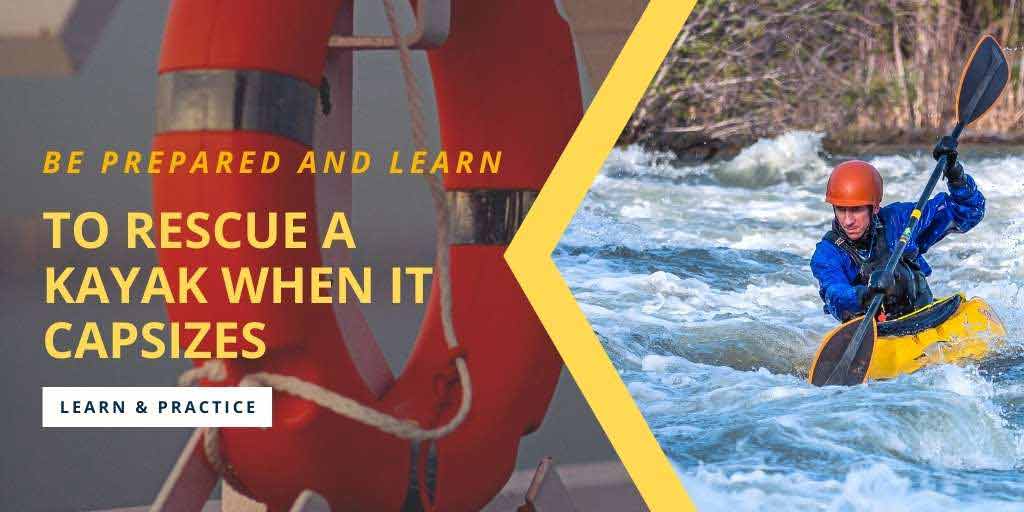No one wants to think about their kayak capsizing, but it’s always best to be prepared than to be sorry! That’s why learning to rescue a capsized kayak is an important skill that every kayaker should know.
It’s a good idea to practice kayak rescues with a friend or family member before you head out on the water.
And if you find yourself in the water and your kayak is overturned, don’t panic. There are a few things you can do to rescue yourself and your kayak.
This article will explain different techniques for rescuing a kayak, and how to perform them accurately. Let’s begin with why a kayak capsized;
Jump To A Section
Why is a kayak capsized?
We’ve all been there. You’re out on the water, enjoying a beautiful day paddling your kayak. But then, without warning, your kayak capsizes!
It’s a frustrating and often scary experience. But why does it happen? There are a few different reasons why a kayak might capsize.
Let’s take a look at some of the most common causes;
Wind
One of the most common reasons for a kayak to capsize is wind. Strong winds can easily push a kayak over, especially if it’s not properly secured.
Waves
Another common cause of capsizing is waves. Even small waves can cause a kayak to tip over if you’re not careful.
Currents
Strong currents can also be a problem, especially if you’re paddling in open water. Currents can quickly push a kayak off course, and if you’re not paying attention, you might find yourself in trouble.
Weight Distribution
Finally, weight distribution is important when paddling a kayak. If you’re not evenly distributing your weight, it’s easy to tip the kayak over.
Poor Paddling Technique
Sometimes, a kayak will capsize simply because of poor paddling technique. If you’re not using the proper form, it’s easy to tip your kayak over.
These are just a few of the most common reasons why a kayak might capsize. If you’re ever being capsized, don’t panic. Stay calm and follow the proper rescue for righting your kayak.
Learn to Quickly Perform a Kayak Rescue
If you’re new to kayaking, or even if you’ve been paddling for a while, it’s important to know how to perform a kayak rescue.
A kayak rescue is when you help another kayaker who has capsized or is in danger of capsizing.
Here are some tips on how to quickly perform a kayak rescue:
Step 1
First, assess the situation. If someone is in immediate danger, call for help and then proceed with the rescue. If the situation is not urgent, you can assess it yourself and decide whether or not you need to call for help.
Step 2
Approach the kayaker from behind. This will help keep you both stable.
Step 3
Grab the kayaker’s paddle. You can use this to help stabilize the kayak and keep it from flipping over.
Step 4
Lift the kayak up. Put your paddle under the kayak and lift it up so that the kayaker can get out.
Step 5
Right the kayak. Once the kayaker is out, you can right the kayak and paddle it to shore.
Kayak rescues can be tricky, but with a little practice, you’ll be able to do them like a pro!

Different Techniques For Rescuing a kayak
There are two main types of kayak rescues: self-rescue and assisted rescue. Self-rescue is when you right your own kayak after it has capsized. Assisted rescue is when you help someone else right their kayak or get to safety.
If you’re paddling with a group, someone may be able to tow you to safety. If you’re kayaking alone, you may need to self-rescue.
Knowing how to do both self-rescue and assisted rescue is important, as you never know when you might need to use one or the other.
Let’s have a close look at some of the different techniques that you can use for self-rescue and assisted rescue;
self-rescue
Kayak self-rescue is the process of getting yourself and your kayak to safety in the event of an emergency. This could be due to capsizing, being caught in a current, or any other number of potentially dangerous situations.
Self-rescue is an essential skill for all kayakers, regardless of experience level. Even the most experienced paddlers can find themselves in situations beyond their control, so it’s always best to be prepared.
The most important thing is to stay calm and think clearly. This will help you to assess the situation and make the best decision about how to proceed.
There are a number of different techniques that can be used for kayak self-rescue, and the best one to use will depend on the specific situation you find yourself in. We’ll go through some of the most common techniques below;
Common Techniques For Kayak Self-Rescue
As we mentioned, there are a number of different kayak self-rescue techniques that can be used in different situations. Some of the most common include:
Paddle Float Self Rescue
The paddle float self-rescue is a great way to get yourself out of a dangerous situation when you are paddling alone.
This technique can be used if you capsize or if your kayak starts to fill with water.
Here’s how you can easily apply a paddle float technique for self-rescue;
The first step is to secure your paddle to the kayak. You can do this by tying the paddle to the kayak with a rope or by using a paddle leash.
Next, you will need to inflate your paddle float. Once the paddle float is inflated, you will place it under your kayak seat.
Now, you will need to climb on top of the paddle float. Make sure that you are in a comfortable position and that you are able to reach the kayak paddle.
Once you are on top of the paddle float, you will need to use the kayak paddle to propel yourself toward the shoreline. It is important to paddle in a straight line so that you do not end up going in circles.
As you get closer to the coast, you will need to start preparing for the final step of the Paddle Float Self Rescue. This final step is known as the rescue assist.
The rescue assist is where you will use the kayak paddle to help you get out of the water and onto the shore. You will need to place the paddle across your chest and under your armpits.
Once you are on the shoreline, you can then untie the rope or leash from the kayak and paddle away.
Learning how to perform a Paddle Float Self Rescue is a great way to stay safe while paddling alone. This maneuver can save your life in a dangerous situation.
Eskimo Roll
An Eskimo roll is a kayaking self-rescue technique that is used to right a capsized kayak. This maneuver is also known as an “upside-down roll.”
It’s a relatively simple maneuver, but it can be tricky to master.
Most kayakers hardly know how to perform an Eskimo roll, but it’s an important skill to know in case of an emergency.
The roll is performed by quickly rotating the kayak and body from an upside-down position to an upright position.
Here’s a step-by-step guide to performing an Eskimo roll for a kayak self-rescue:
1. Start in a position known as the “hanging out” position, with your paddle float attached to your kayak and your paddle blade in the water.
2. Reach your paddle across your body and plant the blade in the water on the opposite side of the kayak.
3. Use the paddle blade to push against the water and roll the kayak onto its side.
4. As the kayak starts to roll, tuck your knees into your chest and rotate your hips so that you end up in an inverted position.
5. Grab the paddle with both hands and use it to push down on the water, keeping the kayak submerged.
6. When the kayak is fully inverted, use your legs to push up against the bottom of the kayak and roll it back over.
7. You should now be back in the “hanging out” position. If not, repeat the steps until you are.
8. Once you’re in the “hanging out” position, you can either stay there and wait for help or try to swim to the coastline.
If you find yourself in a situation where you need to perform an Eskimo roll, stay calm and follow the steps above. With practice, you’ll be able to do it quickly and efficiently.
Wet Exit
One of the worst things that can happen when you’re kayaking is called a “wet exit.” That’s when you have to get out of your kayak in the water – and it’s not always easy!
If your kayak tips over or “capsizes,” you’ll need to get out quickly before it fills with water and sinks. Even if you’re wearing a life jacket, it’s still important to get out of the kayak as soon as possible.
Once you’re out of the kayak, you can then right it and get back in. But if you’re by yourself, it can be hard to do this. That’s where the wet exit comes in.
Here’s a step-by-step guide on how to do a wet exit:
1. If you find yourself upside down in your kayak, reach up with your paddle and push the paddle blade away from you to release yourself from the paddle.
2. Grab the rim of your kayak cockpit with both hands.
3. Open your hips and twist your body so you can bring your legs out of the kayak.
4. As you’re exiting the kayak, be sure to keep your head up and pointed in the direction you want to go. You don’t want to get tangled up in the kayak or paddle.
5. Once you’re out of the kayak, swim to the coastline or to a safe place.
It’s always a good idea to practice wet exits in different types of clothing so you can see how it affects your ability to get out of the kayak. For example, try doing a wet exit while wearing a life jacket and while not wearing one.
Assisted rescue
If you can’t self-rescue, you’ll need to get help from someone else. Assisted rescue is when someone else helps you right your kayak or gets you out of the water.
For assisted rescue, the most common technique is for the other person to pull you out of the water with a rope. This is known as a “tow.” The other person will usually paddle their kayak next to yours and then use the rope to tow you back to shore.
Another assisted rescue technique is for the other person to paddle their kayak next to yours and help you to get back in. This is known as a “rescue assist.”
There are a few different ways to do an assisted rescue. Here are some of them;
T-Rescue
T-rescue is a kayaking technique that you can use to rescue another kayaker who has capsized. To perform a T-rescue, you’ll need to approach the capsized boat from the side or behind.
To do this rescue, another kayaker paddles up to the capsized kayaker and grasps their ankles. The rescuer then pulls the kayaker towards them, flipping them over, so they are right-side up. The kayaker can then be pulled to safety.
Here’s a step-by-step guide to T-Rescuing:
1. Approach the capsized kayak from the front, keeping the bow of your kayak pointed toward the stern of the capsized kayak.
2. Grab the capsized kayak by the stern (back end), and position your kayak so that the capsized kayak is resting across your lap.
3. Lift the stern of the capsized kayak out of the water, and then bring the bow of the capsized kayak up and over your head.
4. Flip the capsized kayak right-side up, and then slide the paddler back into the cockpit.
5. Paddle away from the capsized kayak, and be sure to keep an eye on the paddler in case they need assistance.
The T-Rescue is a relatively simple maneuver, but it’s important to practice it before you need to use it in a real-life situation. Be sure to review the steps with a friend or fellow paddler, and always wear a life jacket when you’re on the water.
Advantage of the kayak T-rescue
The main advantage of T-rescuing is that it can be done quickly and easily. It’s also a good choice if the capsized kayaker is wearing a life jacket since it will be easier to flip over.
The disadvantage of the kayak T-rescue
The main disadvantage of the kayak T-rescue is that it can be difficult to do if the water is rough or the kayakers are far apart. If the rescuer can’t reach the kayaker’s ankles, they may have to paddle over to them and try to grab them from behind, which can be tricky.
hi-rescue
Kayak hi-rescue is the act of rescuing someone from a kayak, usually in a situation where they are unable to get out of the kayak or get to shore on their own. This can be due to a variety of reasons, including capsizing, falling out of the kayak, or being pinned underneath the kayak.
Here are a few things that you need to bear in mind for performing a hi-rescue properly;
Stay calm: it’s important to stay calm in a kayak hi-rescue situation, both for your own safety and the safety of the person you’re rescuing.
Be prepared: familiarize yourself with the steps of kayak hi-rescue before you head out on the water, so you’ll be ready if the situation arises.
Have the right gear: as we mentioned, having the right gear can make a kayak hi-rescue much easier. Make sure you have a tow rope, throw bag, and life jacket in your kayak before you head out.
By being prepared, you can help ensure a successful rescue if the situation ever arises. If you are in trouble, make sure to signal for help. Make noise, wave your arms, and do whatever you can to attract attention.
advantage of the HI-rescue
The main advantage of the HI-rescue technique is that it can be done even if the water is rough or the kayakers are far apart. It’s also a good choice if the capsized kayaker is not wearing a life jacket since it will be easier to flip over.
the disadvantage of the HI-rescue
The main disadvantage of the HI-rescue technique is that it can be difficult to do if the kayaker is wearing a life jacket. If the rescuer can’t reach the kayaker’s wrists, they may have to paddle over to them and try to grab them from behind, which can be tricky.
These are just a few of the most common kayak rescue techniques. Be sure to familiarize yourself with all of them before heading out on the water.
Essential Equipment For Kayak Rescue
There are many different pieces of equipment that can be used for kayak rescue, but some of the most essential are listed below.
Paddle Leash
A paddle leash is a strap that attaches your paddle to the kayak, preventing it from floating away if you capsize. This is an essential piece of equipment for all kayakers.
A paddle leash is a strap that attaches your paddle to the kayak, preventing it from floating away if you capsize. This is an essential piece of equipment for all kayakers.
Throw Bag
A throw bag is a small bag that contains a length of rope. It is designed to be thrown to a kayaker who is in trouble so that they can be pulled to safety.
A Tow Line
A tow line is a rope that you can use to tow a kayaker to safety. It is important to have a tow line that is long enough to reach the kayaker but not so long that it gets tangled.
Paddle Float
A paddle float is an inflatable device that can be attached to your paddle and used to support yourself while you climb back into your kayak.
A paddle float is an inflatable device that can be attached to your paddle and used to support yourself while you climb back into
A Knife
A knife can be used for many things, including cutting a tow line if it gets tangled.
Kayak rescue is an important skill for any kayaker. By having the right equipment and knowing how to use it, you can help yourself or another kayaker in trouble!
To sum up, it doesn’t matter what type of rescue you find yourself in, and it is important to remain calm and follow the instructions of the person who is leading the rescue. By doing so, you can ensure that everyone involved in the rescue stays safe and that the rescue is successful.


